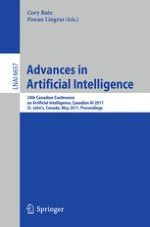2011 | Buch
Advances in Artificial Intelligence
24th Canadian Conference on Artificial Intelligence, Canadian AI 2011, St. John’s, Canada, May 25-27, 2011. Proceedings
herausgegeben von: Cory Butz, Pawan Lingras
Verlag: Springer Berlin Heidelberg
Buchreihe : Lecture Notes in Computer Science
